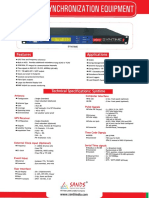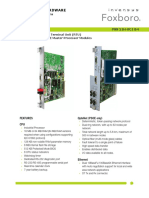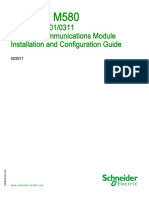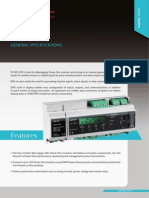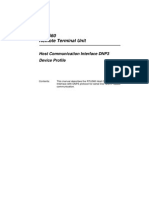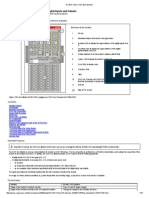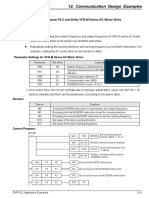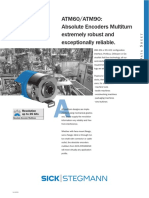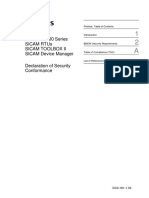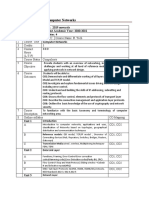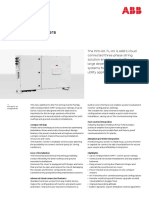Connections and Settings: Communication Unit 560CMU05
Connections and Settings: Communication Unit 560CMU05
Uploaded by
Mohammed MostefaiCopyright:
Available Formats
Connections and Settings: Communication Unit 560CMU05
Connections and Settings: Communication Unit 560CMU05
Uploaded by
Mohammed MostefaiOriginal Title
Copyright
Available Formats
Share this document
Did you find this document useful?
Is this content inappropriate?
Copyright:
Available Formats
Connections and Settings: Communication Unit 560CMU05
Connections and Settings: Communication Unit 560CMU05
Uploaded by
Mohammed MostefaiCopyright:
Available Formats
RTU560 product line
Communication Unit 560CMU05
Connections and settings
Application, characteristics and technical data have to be taken The module has one jumper X1 (see Fig. 5 and 6), to force the
from the hardware data sheet: IP-address of the Ethernet interface to a default value. If the
jumper is set to 1-2 after a restart, the Ethernet interface E1
560CMU05 Data sheet 1KGT 150 619 will be initialized with the IP-address 192.168.0.1 (Subnet mask
255.255.255.0, Gateway 192.168.0.20).
Operation The connection to the RTU560 Serial Peripheral Bus (SPB) and
the RTU560 System Bus is done via 48 pole DIN-F socket con-
The communication unit 560CMU05 is one of the CMU mod- nector according to DIN 41612.
ules (CMU = communication unit) of the RTU560 product line.
The 560CMU05 controls process events and communications
with control centers and local MMI systems via up to four se- Communication interfaces
rial interfaces (CP1, CP2, CPA, CPB) and the two Ethernet
10BaseT/100BaseT LAN interfaces (E1, E2). On all interfaces different protocol types can be used. Possible
limitations can be found in the document: RTU500 series Inter-
faces and protocols (1KGT 150 853).
E1 E2 CP1, CP2
RS232C or
10/100 MB LAN 10/100 MB LAN
RS485
Ethernet Interfaces E1 and E2
The Ethernet interfaces E1 and E2 on the Front plate supports
Ethernet Ethernet different functions:
USART
Controller Controller – Webserver-diagnostic with download of configuration files
and firmware
– Protocol IEC 60870-5-104, DNP3, …
– Integrated HMI
Processor bus
The signals are used according to:
MPU RAM/Flash
Ethernet Interfaces
ELAN520 Memory
Pin Signal Input/Output
RJ45
1 TD + Output
RAM 2 TD - Output 1
3 RD + Input
8
4 Not used
Jack
SLC 5
CPA, CPB
6 RD - Input
RS232C,
RS485 or
7 Not used
SPB
8
Shield Connected
Figure 1: 560CMU05 Block diagram CMU
with housing
Each network segment can have a maximum cabling distance
of 100 metres with Cat-5-cable.
ADVICE The RS485 cable length should be less than 150 m.
In case of longer cable length adequate provisions for poten-
ADVICE
tial equalization must be ensured to prevent damage on the
modules and installations. In case of longer cable length adequate provisions for poten-
tial equalization must be ensured to prevent damage on the
modules and installations.
Serial Interfaces CP1 and CP2
The serial interfaces CP1 and CP2 are available on the RJ45 Serial Interfaces CPA and CPB
connectors on the front plate. It can interface RS232C and
RS485 signals. The interfaces CP1 and CP2 are connected to The communication interfaces CPA and CPB have two different
an USART (universal synchronous/asynchronous receiver/trans- functions:
mitter). On both interfaces different UART based protocol types – SPB I/O bus connection
can be used. – UART character based protocols
In RS232C mode the signals are used according to: Both functions are mutually exclusive. The SPB allocates always
both interfaces in parallel. In this case the interface CPB is auto-
Serial Interface RS232C Mode matically routed to the 48 pole DIN-F socket connector of the
CMU.
Pin Signal Input/Output
1 DCD Input RJ45
If the interfaces are running in UART-mode, both interfaces can
2 RxD Input 1
handle different communication protocols.
3 TxD Output
8
In RS232C mode the signals are used according to:
4 DTR Output
5 GND -
Jack Serial Interface RS232C Mode
7 RTS Output Pin Signal Input/Output
8 CTS Input 1 DCD Input RJ45
Shield Connected 2 RxD Input 1
with housing 3 TxD Output
8
4 DTR Output
The RS232C standard defines a maximum cable length of 15 m. Jack
5 GND -
In RS485 mode both sides of the serial bus must be terminated 7 RTS Output
by a 1 kΩ resistor. The termination on the CMU side is already
8 CTS Input
done onboard.
Shield Connected
The signals are used according to: with housing
Serial Interface RS485 Mode The RS232C standard defines a maximum cable length of 15 m.
Pin Signal
In RS485 mode both sides of the serial bus must be terminated
RJ45
1 - Not used by a 1 kΩ resistor. The termination on the CMU side is already
2 TA Data - 1
done onboard.
3 TB Data +
8
The signals are used according to:
4 - Not used
Jack
5 GND Signal Ground Serial Interface RS485 Mode
6 - Pin Signal
1 - Not used RJ45
7 - Not used
8 - 2 TA Data - 1
Shield Connected 3 TB Data +
8
with housing 4 - Not used
Jack
5 GND Signal Ground
2 | 1KGT 150 620 V002 1 - Communication Unit 560CMU05
Serial Interface RS485 Mode Parameter name Default Parameter location
6 -
Interface Type RS232C CMU parameter - serial inter-
7 - Not used faces
8 - value range: RS232C, RS485 or fix if selection is not supported
Shield Connected COM Speed 9600 bits/sec CMU parameter - serial inter-
with housing faces
value range: 50, 75, 100, 110, 150, 200, 300, 600, 1200, 1500, 2400, 4800,
The RS485 cable length should be less than 150 m. 9600, 19200, 38400 bits/sec; 50-600 bits/sec only on selected interfaces
Modem control direct link CMU parameter - serial inter-
ADVICE (TxD/RxD on- faces
ly)
In case of longer cable length adequate provisions for poten-
tial equalization must be ensured to prevent damage on the Modem control:
modules and installations. – Direct link (TxD/RxD only)
– WT link full duplex (no handshake)
– WT link half duplex (RTS/CTS handshake)
Signaling – WT link half duplex (RTS / DCD handshake)
– Dial up (external modem DCD handshake)
– Loop switch unit (RP570/71 Host interface only, DSTC 3002)
Signaling by LEDs
– Link with collision avoidance (DCD handshake, DNP 3 only)
ERR (red) ON: RTU in error state
Transmit delay time disabled CMU parameter - serial inter-
Flashing: RTU in warning state
faces
For more details see RTU500 series
value range: disabled, 1... 10000 ms
Function Description
Tx (green) Transmit data on serial communica-
Following parameters can be defined for Ethernet interfaces:
tion ports CP
Rx (green) Receive data on serial communication
Parameter name Default Parameter location
ports CP
A (green) Activity on Ethernet interface E Interface mode Auto-Negotia- CMU parameter - Network In-
tion terfaces
L (green) Link up on Ethernet interface E
Interface Mode:
– Auto-Negotiation
Firmware Version –
–
100BaseT full duplex
100BaseT half duplex
– 10BaseT full duplex
The actual firmware version will be delivered on a CompactFlash
– 10BaseT half duplex
memory card. A new firmware file can be loaded with the Web
diagnostic tool into the removable CompactFlash memory card. Node name none CMU parameter - Network In-
Exchanging of CompactFlash memory cards is possible. terfaces
IP Address none CMU parameter - Network In-
terfaces
Settings
Subnet mask 0.0.0.0 CMU parameter - Network In-
The settings of the hardware and for operation of the communi- terfaces
cation interface is done with the RTUtil500 configuration tool. Default Gateway IP 0.0.0.0 CMU parameter - Network In-
terfaces
Following parameters can be defined for serial interfaces:
The module has one jumper X1 (see Fig. 4) to force the IP-ad-
dress of the Ethernet interface to a default value. If the jumper
is set to Position 1-2 after a restart, the Ethernet interface E1
will be initialized with the IP-address 192.168.0.1 (Subnet mask
255.255.255.0, Gateway 192.168.0.20).
Communication Unit 560CMU05 - 1KGT 150 620 V002 1 | 3
Junper X1 in
position 2-3
No Yes
?
Read IP address
Send Configuration from configuration
to RTU 192.168.0.1 file
Set
jumper X_ETH
to position 2-3
end
Figure 2: 560CMU05 use of jumper X1
560CMU05
ERR
E1
E2
R R
A 1 1 2 3
T T
R R
B
X1
2
T T
1-2 = Default IP
192.168.0.1
Figure 3: 560CMU05
front plate Figure 4: 560CMU05 jumper positions
4 | 1KGT 150 620 V002 1 - Communication Unit 560CMU05
ABB AG Note:
Power Systems Division The specifications, data, design or other information contained in this document
P.O. Box 10 03 51 (the “Brochure”) - together: the “Information” - shall only be for information pur-
68128 Mannheim, Germany poses and shall in no respect be binding. The Brochure does not claim to be ex-
haustive. Technical data in the Information are only approximate figures. We re-
www.abb.com/substationautomation serve the right at any time to make technical changes or modify the contents of
this document without prior notice. The user shall be solely responsible for the
use of any application example or information described within this document.
The described examples and solutions are examples only and do not represent
any comprehensive or complete solution. The user shall determine at its sole
discretion, or as the case may be, customize, program or add value to the ABB
products including software by creating solutions for the end customer and to
assess whether and to what extent the products are suitable and need to be ad-
justed or customized.
This product is designed to be connected to and to communicate information
and data via a network interface. It is the users sole responsibility to provide and
continuously ensure a secure connection between the product and users or end
customers network or any other network (as the case may be). The user shall es-
tablish and maintain any appropriate measures (such as but not limited to the in-
stallation of firewalls, application of authentication measures, encryption of da-
ta, installation of anti-virus programs, etc) to protect the product, the network,
its system and the interface against any kind of security breaches, unauthorized
access, interference, intrusion, leakage and/or theft of data or information. ABB
AG is not liable for any damages and/or losses related to such security breaches,
any unauthorized access, interference, intrusion, leakage and/or theft of data or
information.
ABB AG shall be under no warranty whatsoever whether express or implied and
assumes no responsibility for the information contained in this document or for
any errors that may appear in this document. ABB AG's liability under or in con-
nection with this Brochure or the files included within the Brochure, irrespective
of the legal ground towards any person or entity, to which the Brochure has been
made available, in view of any damages including costs or losses shall be exclud-
ed. In particular ABB AG shall in no event be liable for any indirect, consequen-
tial or special damages, such as – but not limited to – loss of profit, loss of pro-
duction, loss of revenue, loss of data, loss of use, loss of earnings, cost of cap-
ital or cost connected with an interruption of business or operation, third party
claims. The exclusion of liability shall not apply in the case of intention or gross
negligence. The present declaration shall be governed by and construed in ac-
cordance with the laws of Switzerland under exclusion of its conflict of laws rules
and of the Vienna Convention on the International Sale of Goods (CISG).
ABB AG reserves all rights in particular copyrights and other intellectual property
rights. Any reproduction, disclosure to third parties or utilization of its contents -
in whole or in part - is not permitted without the prior written consent of ABB AG.
© Copyright ABB 2014
All rights reserved
Communication Unit 560CMU05 - 1KGT 150 620 V002 1 | 5
You might also like
- e560CVD03 InstructionManual v12Document76 pagese560CVD03 InstructionManual v12gnyankovNo ratings yet
- Networking DocumentationDocument26 pagesNetworking DocumentationAdwitiya Saigar100% (4)
- Setting PC Tool: Instruction ManualDocument22 pagesSetting PC Tool: Instruction ManualminhchiNo ratings yet
- RTU560 InterfaceDocument15 pagesRTU560 Interfacehare ramNo ratings yet
- Unity Pro System Bits Words (112pages)Document112 pagesUnity Pro System Bits Words (112pages)hunza100% (1)
- SDG Quick Start Guide PDFDocument14 pagesSDG Quick Start Guide PDFedmuarizt7078No ratings yet
- InteliSys-NTC Hybrid - DatasheetDocument4 pagesInteliSys-NTC Hybrid - DatasheetMaylen RivasNo ratings yet
- Abb Rtu560 PDFDocument2 pagesAbb Rtu560 PDFRidzky AryaNo ratings yet
- Analog Input Module 6ES7 331-7NF00-0AB0Document9 pagesAnalog Input Module 6ES7 331-7NF00-0AB0Trần Quang LinhNo ratings yet
- Sands GPS DocumentsDocument7 pagesSands GPS Documentsrpaliwal1967100% (1)
- User Manual: Configuration With Web Interface Controller CSU 502Document10 pagesUser Manual: Configuration With Web Interface Controller CSU 502moumen BoughraraNo ratings yet
- RADWIN 5000 4 9 75 Release Note PDFDocument24 pagesRADWIN 5000 4 9 75 Release Note PDFChristian Javier Lopez Duran100% (1)
- Abb Ag: Remote Terminal Unit Onnections and Settings DIN Rail RTU 560CIG10Document16 pagesAbb Ag: Remote Terminal Unit Onnections and Settings DIN Rail RTU 560CIG10Cosmic Garash 2No ratings yet
- Data Sheet: Communication Unit 560CMR01Document5 pagesData Sheet: Communication Unit 560CMR01Mohammed MostefaiNo ratings yet
- 21h8c1b4 - IA Series® Remote Terminal Unit (RTU) RTU50Document8 pages21h8c1b4 - IA Series® Remote Terminal Unit (RTU) RTU50Muhd Nu'man H0% (2)
- RTUtil560 Users Guide R8Document101 pagesRTUtil560 Users Guide R8Rounak BrahmaNo ratings yet
- FD Rel11 Part9 Interfaces and Networks PDFDocument69 pagesFD Rel11 Part9 Interfaces and Networks PDFUmutNo ratings yet
- 09 1 Default IP Address EDocument12 pages09 1 Default IP Address EFinet CyrilleNo ratings yet
- Pvi-Aec-Evo: ABB Monitoring and CommunicationsDocument4 pagesPvi-Aec-Evo: ABB Monitoring and CommunicationsroscribNo ratings yet
- Abb Utilities GMBH: Remote Terminal Unit Connections and Settings Modem 23Wt21Document8 pagesAbb Utilities GMBH: Remote Terminal Unit Connections and Settings Modem 23Wt21AlikNo ratings yet
- Realization of IEC 60870-5-104 Protocol in DTUDocument6 pagesRealization of IEC 60870-5-104 Protocol in DTUKalyan RanjanNo ratings yet
- 00 E560 SD R 9 0Document116 pages00 E560 SD R 9 0ptheabstractNo ratings yet
- RTU560 EnglishDocument16 pagesRTU560 EnglishrhomadonaNo ratings yet
- Part2 Rack Mounted Solutions en PDFDocument43 pagesPart2 Rack Mounted Solutions en PDFBruno Nemer TattonNo ratings yet
- Manual - CP-8050 - ENG - DC8-026-2 - 11 Nov IEC104Document80 pagesManual - CP-8050 - ENG - DC8-026-2 - 11 Nov IEC104Marcial MamaniNo ratings yet
- 10 - 1 RTU560 - PLC - IntroductionDocument42 pages10 - 1 RTU560 - PLC - IntroductionbzyNo ratings yet
- SYN4E For FOX 515/512 SDH STM-1/STM-4 Aggregate Interface: Utility CommunicationsDocument2 pagesSYN4E For FOX 515/512 SDH STM-1/STM-4 Aggregate Interface: Utility Communicationsbertovalen100% (1)
- BMENOC301 User ManualDocument364 pagesBMENOC301 User ManualSunny BadhwarNo ratings yet
- Pvi-Aec-Evo en 2Document4 pagesPvi-Aec-Evo en 2Pirvu ValentinNo ratings yet
- E560 23be50 DSDocument4 pagesE560 23be50 DSSalvador FayssalNo ratings yet
- FactoryTalk View Machine Edition - Data Logging Best PracticesDocument3 pagesFactoryTalk View Machine Edition - Data Logging Best PracticesMartinCastilloSancheNo ratings yet
- 530ADD01 DS enDocument4 pages530ADD01 DS enHatem LaadhariNo ratings yet
- E560 Dnp3 HostDocument69 pagesE560 Dnp3 Hostanak1n888No ratings yet
- Modbus RTU - One JobDocument24 pagesModbus RTU - One JobIsmail ShahidNo ratings yet
- 4CAE000545 - RTU500 Rel. 12.2 Engineer - WebinarDocument48 pages4CAE000545 - RTU500 Rel. 12.2 Engineer - Webinardavid nicolaeNo ratings yet
- E560 DNP3 Host R13Document60 pagesE560 DNP3 Host R13mkvaisakhNo ratings yet
- E560 IEC61850 SubDocument42 pagesE560 IEC61850 SubHubert Maraza JaliriNo ratings yet
- Esr-48-40a C DeltaDocument2 pagesEsr-48-40a C Deltasam100% (2)
- FX3U Modbus ManualDocument4 pagesFX3U Modbus ManualDadang Ibnu SetyawanNo ratings yet
- DPR 2700 PDFDocument2 pagesDPR 2700 PDFNdambuki Dickson50% (2)
- Dc551-Cs31 Cs31 Bus ModuleDocument10 pagesDc551-Cs31 Cs31 Bus ModuleMuhammad Usman KhalidNo ratings yet
- Reliable Solutions For Transmission and Sub-Transmission: RTU560 Product LineDocument2 pagesReliable Solutions For Transmission and Sub-Transmission: RTU560 Product Lineluhusapa-1No ratings yet
- PLC To VFD Communication ExamplesDocument9 pagesPLC To VFD Communication Examplesghan100% (4)
- Distributed Control SystemDocument31 pagesDistributed Control SystemAbdullah BarkaNo ratings yet
- E560 Cmu05 DSDocument4 pagesE560 Cmu05 DSJoao SantosNo ratings yet
- Interoperability of The WAGO IEC60870-5-101 and - 104 Protocol LibraryDocument18 pagesInteroperability of The WAGO IEC60870-5-101 and - 104 Protocol LibraryBeltazor HellboyNo ratings yet
- Step by Step For Excel Import IN Rtutil NT SoftwareDocument46 pagesStep by Step For Excel Import IN Rtutil NT SoftwareSalvador FayssalNo ratings yet
- Users Manual UNITROL 1000-PM40 PDFDocument19 pagesUsers Manual UNITROL 1000-PM40 PDFAlexandre100% (1)
- SM 25xx ETA2 DB ENG PDFDocument24 pagesSM 25xx ETA2 DB ENG PDFCristian CastellanosNo ratings yet
- 530AID01 DS en PDFDocument4 pages530AID01 DS en PDFHatem LaadhariNo ratings yet
- LIAN 98 (En) - Protocol IEC 60870-5-103, Telegram Structure PDFDocument5 pagesLIAN 98 (En) - Protocol IEC 60870-5-103, Telegram Structure PDFVINOTH DURAISAMY100% (1)
- User Manual: 2.2KW LS (Low PV Input Range) Solar Inverter For Water PumpDocument22 pagesUser Manual: 2.2KW LS (Low PV Input Range) Solar Inverter For Water PumpJavier EspinozaNo ratings yet
- RTUtil 560 Application PDFDocument21 pagesRTUtil 560 Application PDFGilbert H. Quiroga G.100% (1)
- Atm60 Aaa12x12Document40 pagesAtm60 Aaa12x12Deepak JainNo ratings yet
- MT174 TD v1 - 2 Ang PDFDocument36 pagesMT174 TD v1 - 2 Ang PDFVadimNo ratings yet
- AC500 - V3 - Modbus - RTU - TCP With Third Party DevicesDocument43 pagesAC500 - V3 - Modbus - RTU - TCP With Third Party DevicesSoumya SagarNo ratings yet
- Modbus RtuDocument8 pagesModbus RtuVoicu StaneseNo ratings yet
- v20 Operating Instructions Complete en-US en-USDocument314 pagesv20 Operating Instructions Complete en-US en-USPandu BirumakovelaNo ratings yet
- Connections and Settings: Communication Unit 560CMU02Document5 pagesConnections and Settings: Communication Unit 560CMU02Mohammed MostefaiNo ratings yet
- Connections and Settings: Communication Unit 560CMR01Document4 pagesConnections and Settings: Communication Unit 560CMR01Mohammed MostefaiNo ratings yet
- 560CMU05 DS enDocument5 pages560CMU05 DS enĐồng Nai CT0% (1)
- 520CMD01 CS enDocument4 pages520CMD01 CS enDJ ThangNo ratings yet
- SICAM A8000 Series Sicam Rtus Sicam Toolbox Ii SICAM Device ManagerDocument72 pagesSICAM A8000 Series Sicam Rtus Sicam Toolbox Ii SICAM Device ManagerMohammed MostefaiNo ratings yet
- WG LGHQWLFDWLRQ Sdudpìwultxh GHV V - Vwëph FRQWLQXV 4 V - VwëphvDocument5 pagesWG LGHQWLFDWLRQ Sdudpìwultxh GHV V - Vwëph FRQWLQXV 4 V - VwëphvMohammed MostefaiNo ratings yet
- SICAM TOOLBOX II Version 5.10: New FeaturesDocument7 pagesSICAM TOOLBOX II Version 5.10: New FeaturesMohammed MostefaiNo ratings yet
- 4CAE000907 TRO620 Data SheetDocument5 pages4CAE000907 TRO620 Data SheetMohammed MostefaiNo ratings yet
- Operation: USB Interface U1, U2, U3 and U4Document5 pagesOperation: USB Interface U1, U2, U3 and U4Mohammed MostefaiNo ratings yet
- RTU500 Series: Line Transformer 500LTD03Document3 pagesRTU500 Series: Line Transformer 500LTD03Mohammed MostefaiNo ratings yet
- Data Sheet: HMI Unit 560HMR01Document3 pagesData Sheet: HMI Unit 560HMR01Mohammed MostefaiNo ratings yet
- Data Sheet: Communication Unit 560CMU02Document4 pagesData Sheet: Communication Unit 560CMU02Mohammed MostefaiNo ratings yet
- Connections and Settings: Communication Unit 560CMR01Document4 pagesConnections and Settings: Communication Unit 560CMR01Mohammed MostefaiNo ratings yet
- Connections and Settings: Communication Unit 560CMU02Document5 pagesConnections and Settings: Communication Unit 560CMU02Mohammed MostefaiNo ratings yet
- Connections and Settings: Communication Unit 560CMR01Document4 pagesConnections and Settings: Communication Unit 560CMR01Mohammed MostefaiNo ratings yet
- OSPF - Single Area - Ethernet: Khawar Butt Ccie # 12353 (R/S, Security, SP, DC, Voice, Storage & Ccde)Document11 pagesOSPF - Single Area - Ethernet: Khawar Butt Ccie # 12353 (R/S, Security, SP, DC, Voice, Storage & Ccde)Avishkar GoteNo ratings yet
- ETI UNIT 2 QB For StudentDocument7 pagesETI UNIT 2 QB For Studentgamerdelta48No ratings yet
- No.1 Huawei Transport Network Tech ExpressDocument105 pagesNo.1 Huawei Transport Network Tech Expresszinabuhaddis21No ratings yet
- Compact Mono Laser Printer: Brother - Co.uk/hl1212w-BundleDocument6 pagesCompact Mono Laser Printer: Brother - Co.uk/hl1212w-BundleTestNo ratings yet
- Packet Analysis With Wireshark - Sample ChapterDocument12 pagesPacket Analysis With Wireshark - Sample ChapterPackt Publishing100% (1)
- Ch.12 Wireless NetworkingDocument41 pagesCh.12 Wireless Networkingvictorbittar29No ratings yet
- CSE252-Computer NetworksDocument3 pagesCSE252-Computer NetworksabhaNo ratings yet
- TVL - Computer Systems Servicing 12Document7 pagesTVL - Computer Systems Servicing 12KibasuperNo ratings yet
- 1.3.1.1 Class Activity WAN Device ModulesDocument7 pages1.3.1.1 Class Activity WAN Device Modulesbarry apuliNo ratings yet
- PVS 60-TL Us Inversor PDFDocument4 pagesPVS 60-TL Us Inversor PDFJair SaavedraNo ratings yet
- Setup Instructions:: Major ApplicationsDocument9 pagesSetup Instructions:: Major ApplicationsLuisrojasNo ratings yet
- EPON OLT User ManualDocument31 pagesEPON OLT User ManualRoni ShunilNo ratings yet
- Gse 213 - 1Document7 pagesGse 213 - 1muhammad07066893449No ratings yet
- Exam 350-401 - Pg13Document4 pagesExam 350-401 - Pg13Info4 DetailNo ratings yet
- Cisco CBS 110Document12 pagesCisco CBS 110Miguel Eduardo Sanez IbarraNo ratings yet
- Unit 8 Transport LayerDocument3 pagesUnit 8 Transport LayerarcybercafeakhtarNo ratings yet
- W322 Cellular Eth Router DatasheetDocument2 pagesW322 Cellular Eth Router Datasheetvictor.shi1220No ratings yet
- BeoSound 5 EncoreDocument90 pagesBeoSound 5 Encoretechnicalteam.bosoundNo ratings yet
- Industrial Internet of Things: Recent Advances, Enabling Technologies and Open ChallengesDocument13 pagesIndustrial Internet of Things: Recent Advances, Enabling Technologies and Open ChallengesIvan ValadaresNo ratings yet
- ERAN Capacity Monitoring GuideDocument25 pagesERAN Capacity Monitoring Guidejkpllan3100% (6)
- Catalyst 3750xDocument1,438 pagesCatalyst 3750xFatgiNo ratings yet
- Em-Ade4301 Adw4301Document107 pagesEm-Ade4301 Adw4301Aleluiz LuizNo ratings yet
- Lecture Plan (CSC305 - CN Theory)Document2 pagesLecture Plan (CSC305 - CN Theory)cokope9857No ratings yet
- Internet and Intranet (Ctevt)Document63 pagesInternet and Intranet (Ctevt)Saurav techNo ratings yet
- Telecom Network Design Assignment 003Document8 pagesTelecom Network Design Assignment 003yasar khanNo ratings yet
- Vacon100 Flow Ethernet (Modbus TCP) With Modbus PollDocument6 pagesVacon100 Flow Ethernet (Modbus TCP) With Modbus PollcarlosNo ratings yet
- Usb 3.0 To Gigabit Superspeed Ethernet AdapterDocument3 pagesUsb 3.0 To Gigabit Superspeed Ethernet AdapterFénix Del ToroNo ratings yet
- 3 SubjDocument7 pages3 SubjjenniferpeterNo ratings yet









